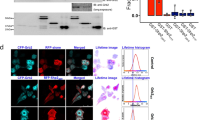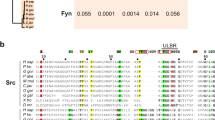Abstract
Src family protein-tyrosine kinase activity is suppressed by two intramolecular interactions. These involve binding of the SH2 domain to the phosphorylated C-terminal tail and association of the SH3 domain with a polyproline type II helix formed by the SH2-kinase linker. Here we show that SH3-dependent activation of the Src family member Hck by HIV-1 Nef binding or by SH2-kinase linker mutation does not affect tail tyrosine phosphorylation in fibroblasts. Surprisingly, replacement of the wild type Hck tail with a high-affinity SH2 domain-binding sequence did not affect Hck activation or downstream signaling by these SH3-dependent mechanisms, suggesting that activation through SH3 occurs without SH2–tail dissociation. These results identify SH3–linker interaction as an independent mode of Hck kinase regulation in vivo and suggest that different mechanisms of Src kinase activation may generate distinct output signals because of differences in SH2 or SH3 domain accessibility.
This is a preview of subscription content, access via your institution
Access options
Subscribe to this journal
Receive 12 print issues and online access
$189.00 per year
only $15.75 per issue
Buy this article
- Purchase on Springer Link
- Instant access to full article PDF
Prices may be subject to local taxes which are calculated during checkout





Similar content being viewed by others
References
Brown, M.T. & Cooper, J.A. Biochim. Biophys. Acta 1287, 121–149 (1996).
Corey, S.J. & Anderson, S.M. Blood 93, 1–14 (1999).
Lowell, C.A. & Soriano, P. Genes Dev. 10, 1845–1857 (1996).
Parsons, J.T. & Parsons, S.J. Curr. Opin. Cell Biol. 9, 187–192 (1997).
Xu, W., Doshi, A., Lei, M., Eck, M.J. & Harrison, S.C. Mol. Cell 3, 629–638 (1999).
Xu, W., Harrison, S.C. & Eck, M.J. Nature 385, 595–602 (1997).
Schindler, T. et al. Mol. Cell 3, 639–648 (1999)
Sicheri, F. & Kuriyan, J. Curr. Opin. Struct. Biol. 7, 777–785 (1997).
Sicheri, F., Moarefi, I. & Kuriyan, J. Nature 385, 602–609 (1997).
Williams, J.C. et al. J. Mol. Biol. 274, 757–775 (1997).
Nada, S., Okada, M., MacAuley, A., Cooper, J.A. & Nakagawa, H. Nature 351, 69–72 (1991).
Yamaguchi, H. & Hendrickson, W.A. Nature 384, 484–489 (1996).
Herna, R.G. & Saksela, K. Front. Biosci. 5, D268–283 (2000).
Lee, C.-H. et al. EMBO J. 14, 5006–5015 (1995).
Saksela, K., Cheng, G. & Baltimore, D. EMBO J. 14, 484–491 (1995).
Moarefi, I. et al. Nature 385, 650–653 (1997).
Briggs, S.D., Sharkey, M., Stevenson, M. & Smithgall, T.E. J. Biol. Chem. 272, 17899–17902 (1997).
Briggs, S.D. & Smithgall, T.E. J. Biol. Chem. 274, 26579–26583 (1999).
Briggs, S.D., Lerner, E.C. & Smithgall, T.E. Biochemistry 39, 489–495 (2000).
Porter, M., Schindler, T., Kuriyan, J. & Miller, W.T. J. Biol. Chem. 275, 2721–2726 (2000).
Alexander, D.R. Semin. Immunol. 12, 349–359 (2000).
Tice, D.A., Biscardi, J.S., Nickles, A.L. & Parsons, S.J. Proc. Natl. Acad. Sci. USA 96, 1415–1420 (1999).
Liu, X. et al. Oncogene 8, 1119–1126 (1993).
Gonfloni, S. et al. EMBO J. 16, 7261–7271 (1997).
Young, M.A., Gonfloni, S., Superti-Furga, G., Roux, B. & Kuriyan, J. Cell 105, 115–126 (2001).
Ma, Y.C., Huang, J., Ali, S., Lowry, W. & Huang, X.Y. Cell 102, 635–646 (2000).
Quintrell, N. et al. Mol. Cell. Biol. 7, 2267–2275 (1987).
Ziegler, S.F., Marth, J.D., Lewis, D.B. & Perlmutter, R.M. Mol. Cell. Biol. 7, 2276–2285 (1987).
Briggs, S.D., Bryant, S.S., Jove, R., Sanderson, S.D. & Smithgall, T.E. J. Biol. Chem. 270, 14718–14724 (1995).
Briggs, S.D. et al. J. Biol. Chem. 276, 25605–25611 (2001).
Boyle, W.J., van der Geer, P. & Hunter, T. Methods Enzymol. 201, 110–149 (1991).
Acknowledgements
Supported by grants from the National Cancer Institute, NIH. E.C.L. is the recipient of an NIH National Research Service Award. The authors would like to acknowledge the NIH AIDS Research and Reference Reagent Program for providing antibodies to HIV-1 Nef.
Author information
Authors and Affiliations
Corresponding author
Ethics declarations
Competing interests
The authors declare no competing financial interests.
Rights and permissions
About this article
Cite this article
Lerner, E., Smithgall, T. SH3-dependent stimulation of Src-family kinase autophosphorylation without tail release from the SH2 domain in vivo. Nat Struct Mol Biol 9, 365–369 (2002). https://doi.org/10.1038/nsb782
Received:
Accepted:
Published:
Issue Date:
DOI: https://doi.org/10.1038/nsb782



